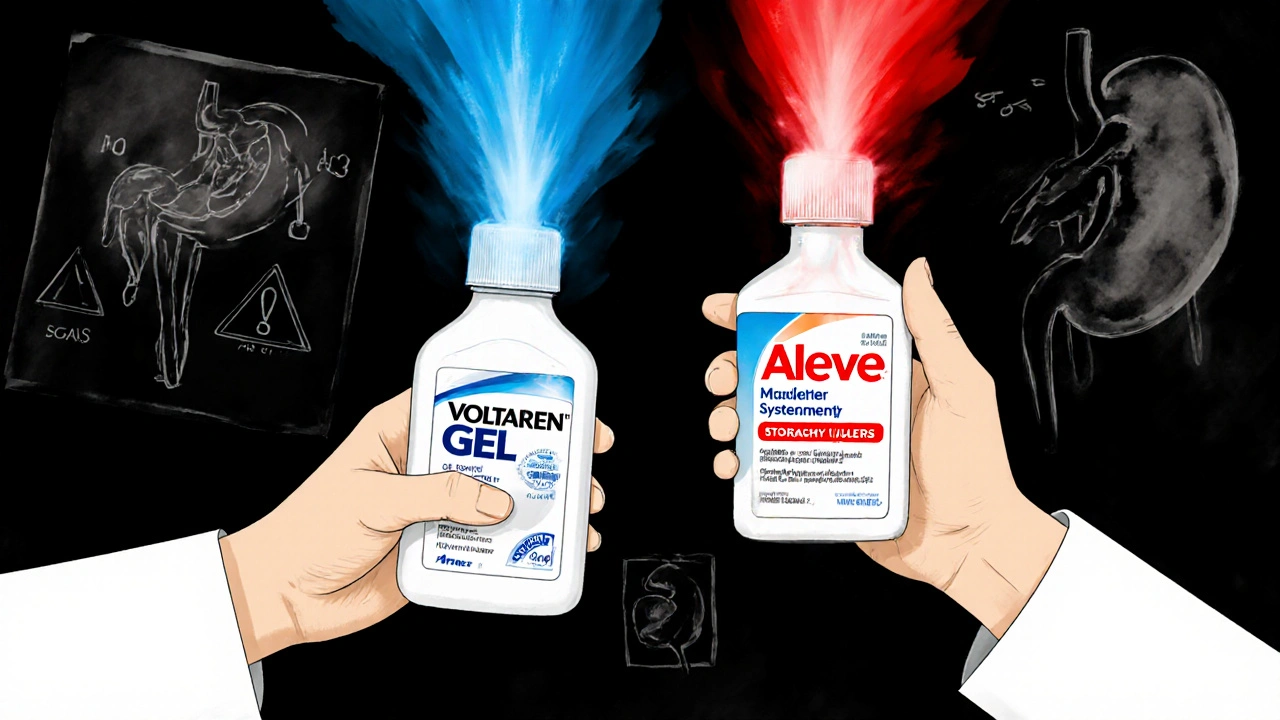When your back locks up, your knees ache after a long walk, or a headache won’t quit, you reach for Aleve. It’s one of the most common over-the-counter pain relievers on the shelf. But is it the best choice? And what happens if it doesn’t work-or gives you stomach trouble? You’re not alone in wondering if there’s something better. Aleve contains naproxen, a nonsteroidal anti-inflammatory drug (NSAID). It’s effective, but it’s not the only option. Let’s break down how naproxen stacks up against the most common alternatives, what each one does best, and who should avoid them.
How Aleve (Naproxen) Actually Works
Aleve’s active ingredient, naproxen, reduces pain and swelling by blocking enzymes called COX-1 and COX-2. These enzymes trigger inflammation, fever, and pain signals. Unlike acetaminophen (Tylenol), which mainly affects pain perception in the brain, naproxen attacks the root cause of discomfort-inflammation. That’s why it’s often recommended for arthritis, tendonitis, menstrual cramps, and muscle strains.
One dose of Aleve (220 mg) lasts up to 12 hours. That’s longer than ibuprofen (Advil, Motrin), which typically wears off in 4 to 6 hours. For people who don’t want to take pills every few hours, that extended relief is a big plus. But longer action doesn’t always mean safer. Naproxen stays in your system longer, which can increase the risk of stomach irritation, especially with daily use.
Advil and Motrin (Ibuprofen): The Short-Term Competitor
Ibuprofen is the most direct alternative to naproxen. Both are NSAIDs. Both reduce inflammation. But there are key differences.
- Dosing: Ibuprofen is usually taken every 4-6 hours. Naproxen is taken every 12 hours.
- Onset: Ibuprofen kicks in faster-about 20-30 minutes. Naproxen takes 30-60 minutes.
- Duration: Naproxen lasts longer, so it’s better for overnight pain or all-day relief.
- Stomach risk: Studies show naproxen carries a slightly higher risk of gastrointestinal bleeding than ibuprofen, especially at high doses or with long-term use.
If you need fast relief for a sudden headache or sprained ankle, ibuprofen might be the better pick. If you’re managing chronic joint pain, naproxen’s longer duration can mean fewer pills per day. But if you’ve ever had an ulcer or acid reflux, ibuprofen may be gentler-though not risk-free.
Tylenol (Acetaminophen): The Non-NSAID Option
Tylenol is not an NSAID. It doesn’t reduce inflammation. It just lowers pain and fever. That makes it a go-to for people who can’t take NSAIDs at all-like those with kidney disease, a history of stomach bleeding, or who take blood thinners.
Here’s the trade-off: Tylenol won’t help with swollen joints or inflamed tendons. If your pain comes from arthritis or a sports injury, it might not cut it. But for headaches, toothaches, or fever, it’s just as effective as naproxen-with far less risk to your stomach or kidneys.
The catch? Tylenol has a narrow safety window. Taking more than 3,000-4,000 mg in a day (especially with alcohol or liver issues) can cause serious liver damage. It’s also in hundreds of cold and flu medicines. People often accidentally overdose by mixing products.
Celebrex (Celecoxib): The Prescription Alternative
Celebrex is a prescription NSAID that targets only the COX-2 enzyme, not COX-1. That means it’s designed to reduce inflammation without irritating the stomach lining as much as naproxen or ibuprofen.
It’s often prescribed for people with osteoarthritis or rheumatoid arthritis who need daily pain relief but have a history of ulcers. Studies show it causes fewer stomach issues than naproxen. But it’s not without risks. Celebrex can raise blood pressure and increase heart attack or stroke risk, especially in people with existing heart disease.
It’s also much more expensive than OTC options. Unless you’ve tried naproxen and ibuprofen and had bad side effects, Celebrex isn’t usually the first choice. It’s a backup, not a replacement.

Topical Pain Relievers: Creams, Gels, and Patches
If you’re dealing with localized pain-like a sore shoulder, stiff knee, or strained wrist-topical NSAIDs might be the smartest move.
Products like Voltaren Gel (diclofenac) and Pennsaid (naproxen liquid) deliver the painkiller right to the skin over the sore area. That means less medicine enters your bloodstream. Less blood exposure = lower risk of stomach problems, kidney strain, or high blood pressure.
Studies show topical diclofenac works just as well as oral NSAIDs for knee and hand osteoarthritis-with a fraction of the side effects. And now, some OTC versions are available without a prescription.
They’re not ideal for deep joint pain or widespread inflammation, but for surface-level aches, they’re a game-changer. No pills. No stomach upset. Just apply and go.
Aspirin: The Original NSAID
Aspirin is the OG NSAID. It’s been around since the 1890s. But for pain relief, it’s rarely the top pick anymore.
- It’s less effective than naproxen or ibuprofen for muscle or joint pain.
- It has a higher risk of stomach bleeding.
- It’s not recommended for children due to Reye’s syndrome.
Aspirin’s main modern use is low-dose (81 mg) for heart attack and stroke prevention in high-risk adults. If you’re taking it for that reason, don’t mix it with naproxen without talking to your doctor. Both thin the blood and can increase bleeding risk.
Who Should Avoid Naproxen Altogether?
Naproxen isn’t safe for everyone. Avoid it if you:
- Have had a stomach ulcer or bleeding
- Have kidney disease or heart failure
- Are pregnant (especially after 20 weeks)
- Are allergic to NSAIDs (rash, wheezing, swelling)
- Take blood thinners like warfarin or clopidogrel
- Have high blood pressure that’s not well controlled
If you’re over 60, you’re at higher risk for side effects-even at low doses. Talk to your doctor before using naproxen daily, even if it’s just one pill every other day.

Real-World Scenarios: Which One Do You Pick?
Let’s say you’re dealing with:
- Monthly cramps: Naproxen is often more effective than ibuprofen for menstrual pain. Many OB-GYNs recommend it.
- Sudden back strain: Ibuprofen for fast relief, then switch to naproxen if pain lingers.
- Arthritis in fingers: Try Voltaren Gel first. If it doesn’t help, then consider oral naproxen.
- Headache with fever: Tylenol is safer if you’re unsure about your stomach or liver.
- Chronic knee pain: If you’re taking something daily, talk to your doctor about topical options or switching to a COX-2 inhibitor.
The best choice isn’t always the strongest. It’s the one that works for your body, your condition, and your risk profile.
What About Natural Alternatives?
People often ask about turmeric, ginger, or omega-3s for pain. Some studies show they have mild anti-inflammatory effects. But they’re not replacements for NSAIDs when you need real, fast relief.
For example, curcumin (in turmeric) may help reduce arthritis pain over weeks or months-but it won’t stop a sudden flare-up. Same with fish oil. It’s good for long-term joint health, but not for an acute injury.
Don’t skip proven meds for supplements unless you’re using them as a complement-not a substitute.
Final Thoughts: No One-Size-Fits-All
Aleve (naproxen) is a solid, long-lasting option for inflammation-related pain. But it’s not the only tool in the box. Ibuprofen works faster. Tylenol is gentler on the stomach. Topical gels cut systemic risk. Celebrex helps if you’ve had GI issues. Aspirin? Stick to heart protection, not pain relief.
Your best move? Start with the lowest effective dose for the shortest time. If one drug doesn’t work-or gives you side effects-try another. Track what helps and what hurts. And if you’re taking pain meds more than a few days a week, talk to your doctor. Chronic pain shouldn’t mean chronic risk.
Is Aleve stronger than ibuprofen?
Aleve (naproxen) isn’t necessarily stronger, but it lasts longer. One dose lasts 12 hours, while ibuprofen wears off in 4-6 hours. For chronic pain, that means fewer pills. For acute pain, ibuprofen kicks in faster. Neither is stronger overall-it’s about duration and timing.
Can I take Aleve and Tylenol together?
Yes, you can safely take Aleve (naproxen) and Tylenol (acetaminophen) together. They work differently-one reduces inflammation, the other just blocks pain signals. Many people use them in combination for better relief, especially with arthritis or post-surgery pain. Just don’t exceed 3,000-4,000 mg of Tylenol per day, and avoid alcohol.
Is naproxen bad for your kidneys?
Yes, long-term or high-dose naproxen can reduce blood flow to the kidneys, which may cause damage-especially if you’re dehydrated, older, or already have kidney disease. Occasional use at recommended doses is usually safe. But if you’re taking it daily for months, get your kidney function checked by a doctor.
What’s the safest OTC pain reliever?
For most people without stomach or kidney issues, occasional use of ibuprofen or naproxen is fine. But if you’re prone to ulcers, have high blood pressure, or take blood thinners, Tylenol (acetaminophen) is usually the safest choice-just watch your dose. For localized pain, topical NSAIDs like Voltaren Gel are the safest overall.
Can I use naproxen for a headache?
Yes, naproxen works well for headaches, especially migraines or tension headaches with inflammation. But it’s not always the fastest. Ibuprofen or Tylenol often work quicker for simple headaches. Naproxen is better if your headache lingers or comes with sinus pressure or neck stiffness.











Wendy Tharp
1 Nov 2025 at 11:44Aleve is just a fancy name for a drug that’s been around since your grandma’s medicine cabinet. People act like it’s some miracle cure, but it’s just another NSAID with a marketing team. I’ve seen way too many people pop these like candy and wonder why their stomach hates them. If you’re taking it daily, you’re not managing pain-you’re gambling with your organs.